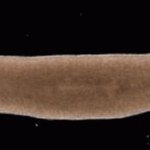
The entrance to Tutankhamun's tomb in the Valley of the Kings. Image: Shutterstock
The microbial growths in the pharaoh’s tomb suggest that he was buried in a hurry.
Tutankhamun died in his late teens and the cause is shrouded in mystery. Various investigations have attributed his demise to sickle cell anaemia, malaria or an injury.
Microbiologist Ralph Mitchell, Harvard University, believes that the walls of his tomb may have a story to tell about the pharaoh’s burial. The elaborately painted walls of the tomb are marred by brown spots, which have seeped into the paint and plaster.
The spots have been analysed by chemists from the Getty Institute of Conservation. They have identified melanins, by-products of fungal and bacterial metabolism.
This suggests that the paint wasn’t dry yet when Tutankhamun was placed in his tomb. Mitchell said in the press release “King Tutankhamun died young, and we think that the tomb was prepared in a hurry.
“We’re guessing that the painted wall was not dry when the tomb was sealed.”
The moisture, the mummy himself and his food and incense would have provided a good environment for microbial growth, until the tomb finally dried out. The presence of these spots led the Egyptian Supreme Council of Antiquities to approach the Getty for help.
There were initially concerns that the presence of the microbes meant that the hordes of tourists visiting the cave and the high humidity might be threatening the site. The Getty approached Mitchell and his team for assistance in identifying the brown spots and whether they posed a hazard to the tomb or the tourists.
While the ancient organisms’ identities remain a mystery, the spot have not been matched to any living microbes. Archana Vasanthakumar, a postdoctoral fellow in Mitchell’s lab, said “Our results indicate that the microbes that caused the spots are dead.
“Or, to put it in a more conservative way, “˜not active.'”
Photographs have also revealed that the brown spots have not changed in the 89 years since tomb was first opened by Howard Carter and his team in 1922. This is good news for the tourists and Egyptologists, as the damage has already been done.
Mitchell predicts that the 3000-year-old microbial growths will be left alone, as they are unique to this site and Tutankhamun’s hasty burial. “This is part of the whole mystique of the tomb.”






